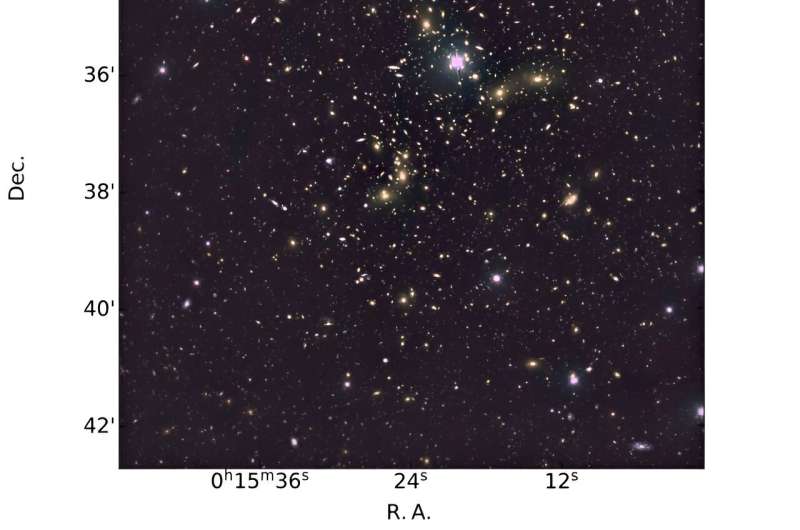February 19, 2024 report
This article has been reviewed according to Science X's editorial process and policies. Editors have highlighted the following attributes while ensuring the content's credibility:
fact-checked
preprint
trusted source
proofread
Pandora's Cluster explored by researchers

Using the Magellan Telescopes in Chile, Italian astronomers have observed a giant galaxy cluster known as Abell 2744, dubbed the Pandora's Cluster. Results of the observational campaign, presented in a paper published February 13 on the preprint server arXiv, provide more insights into the properties of this cluster.
Galaxy clusters contain up to thousands of galaxies bound together by gravity. They form through accretion of mass and infall of smaller sub-structures and are the largest known gravitationally bound structures in the universe. Therefore, they could serve as excellent laboratories for studying galaxy evolution and cosmology.
At a distance of about 4 billion light years from the Earth, the Pandora's Cluster is a giant galaxy cluster estimated to be around 4 trillion times more massive than the sun. It appears to be the result of a simultaneous pile-up of at least four separate, smaller galaxy clusters that took place over a span of 350 million years.
Previous observations of Pandora's Cluster have revealed that it showcases one of the most complex merger phenomena ever detected, observed both in the radio and in the X-ray data. The cluster also drew the attention of a team of astronomers led by Davide Abriola of the University of Milan in Italy as they decided to investigate it with MegaCam—a large mosaic CCD camera on one of the Magellan Telescopes.
"In this paper, we present an improved WL [weak lensing] analysis of the galaxy cluster Abell 2744 using deep Magellan/MegaCam multiband imaging data covering a field of view of approximately 31′ × 33′.... For our study, we applied a pipeline based on two brand-new softwares, mccd and ngmix for the PSF [point spread function] reconstruction and shape measurement, respectively," the researchers wrote in the paper.
First of all, the new observations found that the Pandora's Cluster has a projected total mass of approximately 2.56 quadrillion solar masses—within 7.66 million light years from the south-west brightest cluster galaxy. This makes it one of the most massive galaxy clusters so far discovered.
The reconstructed total surface mass distribution uncovered the presence of three high-density peaks, substructures in the inner core of the Pandora's Cluster. One, with higher density and a signal to noise ratio of 14.0, lies in the south-east part of the cluster, very close to the brightest cluster galaxy, whereas the other two are found in the north-west corner.
According to the authors of the paper, these results confirm that the cluster is not relaxed but is undergoing a complex merger, which was suggested by previous studies. They added that this is also confirmed by a comparison with a new high-precision strong lensing analysis of the cluster's central region, based on the data from the James Webb Space Telescope (JWST).
More information: Davide Abriola et al, An improved Magellan weak lensing analysis of the galaxy cluster Abell 2744, arXiv (2024). DOI: 10.48550/arxiv.2402.08364
Journal information: arXiv
© 2024 Science X Network





















